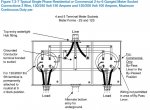You do realize that a PV system is a current limited power source, right? Moreover, power electronics based interactive inverters can contribute very little during fault conditions.
That distinction is just silly, IMO. Most AHJ's take a more pragmatic view; whether they consider a connection a service is a function of the physical wiring, not whether or not it delivers half a kWh over the course of a week.
Yes, I know how inverters work.
I also think quite simply that inside a house does not equal "readily accessible", and the way the term is used in 690.13 contradicts the definition in 100.
Also, if supply side PV isn't a load, service or a separately derived system... what is it?
It's the same wiring when 10kW of power is going out to the grid or
What's wrong with requiring the main PV disco to be adjacent to the meter and outdoors (unless it is impossible to set it up that way),seeing as it is simpler and safer?
690.4 General Requirements
(D) Multiple Inverters. A PV system shall be permitted to
have multiple inverters installed in or on a single building
or structure. Where the inverters are remotely located from
each other, a directory in accordance with 705.10 shall be
installed at each dc PV system disconnecting means, at
each ac disconnecting means, and at the main service disconnecting
means showing the location of all ac and dc PV
system disconnecting means in the building.
705.21 Disconnecting Means, Equipment.
Means shall be provided to disconnect power production equipment,
such as utility interactive inverters or transformers associated
with a power production source, from all ungrounded
conductors of all sources of supply.
III. Disconnecting Means
690.13 Building or Other Structure Supplied by a PhotovoltaicSystem.
Means shall be provided to disconnect
all ungrounded dc conductors of a PV system from all other
conductors in a building or other structure.
(A) Location. The PV disconnecting means shall be jnstalled
at
a readily accessible location either on the outside
of a building or structure or inside
705.22 Disconnect Device. The disconnecting means for
ungrounded conductors shall consist of a manually or
power operable switch(es) or circuit breaker(s) with the
following features:
(1) Located where readily accessible.
Art. 100
Accessible, Readily (Readily Accessible). Capable of being
reached quickly for operation, renewal, or inspections
without requiring those to whom ready access is requisite
to actions such as to use tools, to climb over or remove
obstacles, or to resort to portable ladders, and so forth.


